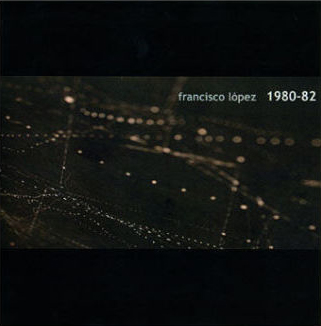 Francisco López came onto my radar beginning during his most prolific period, largely the mid-1990s to the present day. Even though his career began earlier, his 1980s period is often forgotten due to these earliest works published in extremely small numbers that have faded into obscurity. This new compilation, however, presents previously unreleased material from his earliest cassette recordings. Within the context of his expansive body of work, what is most striking is how established his aesthetic and style was, even at such a young age.
Francisco López came onto my radar beginning during his most prolific period, largely the mid-1990s to the present day. Even though his career began earlier, his 1980s period is often forgotten due to these earliest works published in extremely small numbers that have faded into obscurity. This new compilation, however, presents previously unreleased material from his earliest cassette recordings. Within the context of his expansive body of work, what is most striking is how established his aesthetic and style was, even at such a young age.
López’s approach to composition was already heavily ingrained in his work from the beginning and was largely born out of necessity.This becomes apparent within the first listen. Unable to afford conventional instruments at this time, his first works were the result of experimenting with cheap cassette recorders and players, which is the method that these untitled pieces were created with.Within these he creates complex studies of sound, working with a sparse palette of source material but utilizing and exploring them with an unparalleled depth and intensity.
The actual techniques remain ambiguous, but parts sound as if they were based upon amplifying and looping the imperfections of analog media.The first features heavy sub bass wavering, like a slightly off center tape reel, and a hum that may be fragments of a tape motor running, with the volume maximized and then reduced.Francisco continues on to incorporate what could be some white noise or static interference to produce a more expansive sound with significant amounts of variation and shifting dynamics.
López works with more textural elements on the third composition, largely the errant click or bit of grinding noise that is isolated and utilized as a recurring element rather than the passing glitch of a damaged bit of tape.This use of subtle textures and open spaces is not at all too dissimilar to his modern day work, just somewhat less pristine in presentation due to the analog, rather than digital source of sounds and his tools of manipulation.Knowing the low fidelity methods used to create these compositions is one of this album's strongest assets.
The final two, lengthy pieces are perhaps most in line with his modern work that examines sounds that barely rise above absolute silence, and neither would have been out of place on his Presque Tout (Quiet Pieces 1993-2013) collection from 2014.The fifth piece drifts from a hum resonating down a long hallway into a rumbling, subterranean churn.At times it resembles what I imagine the deepest part of the ocean would sound like, eventually shifting to such low frequencies to be almost imperceptible by human hearing.This blends in nicely to the final piece, which is also built around nearly invisible low-end noises.Here it is almost a rhythmic pulsing that becomes lower and lower in pitch until ending with practically nothingness.
Even with his means of composition limited to such rudimentary tools over 30 years ago, Francisco López began his career in sound out rather fully formed and realized.These early works may be structurally more basic than what he has become most known for, but for such a young artist with basic tools, he managed to begin the sound that he has refined with each subsequent release.Considering how much of a pioneer he has been in this genre, it is fascinating that even his most tentative works remain strong nearly three and a half decades after their creation.López's work has always resonated with me because it requires such focused and dedicated attention, keeping me engaged in everything I have heard from him.Knowing the conditions under which this material was recorded gave me an additional layer of appreciation, and also a greater curiosity as to how he created it.For that reason alone 1980-82 stands out amidst the best of his most recent work.
samples:
 
Read More

